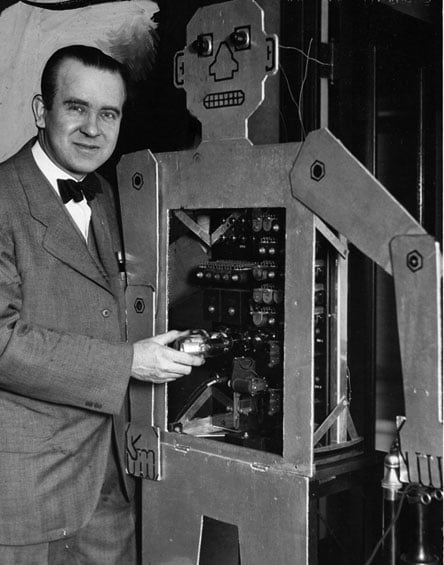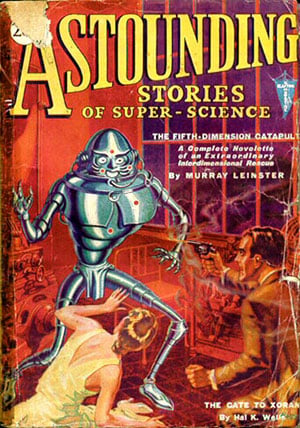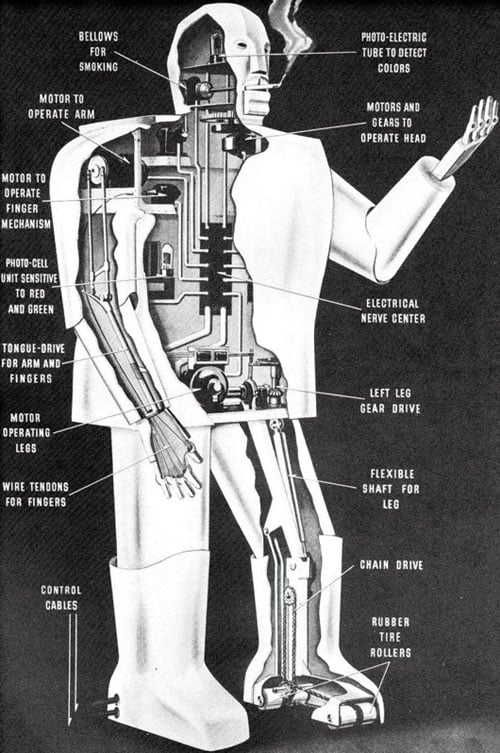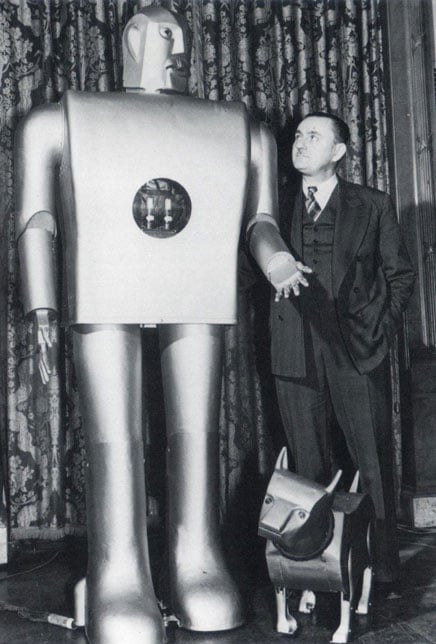8 Facts about Elektro of Westinghouse
- The Elektro was constructed from aluminum on a steel frame. It was 210 cm tall, weighing 120 kg.
- It was capable of performing 26 routines (movements), and a vocabulary of 700 words.Sentences were formulated by a series of 78 RPM record players connected to relay switches.
- Elektro had no remote control, instead responding to voice commands using a telephone handset connected to its chest. The chest cavity even lit up as it recognized each word.
- His fingers, arms and turntable for talking were operated by nine motors, while another small motor worked the bellows so the giant could smoke.
- With a loud electrical whine, Elektro would walk about the stage in a slow slide that betrayed the rollers on his feet.
- Exciting things that Elektro could do was move his head and arms, count on his fingers, recognise colors (his photoelectric “eyes” could distinguish red and green light), smoke cigarettes, and talk.
- Elektro was on exhibit at the 1939 New York World’s Fair and reappeared at that fair in 1940, with a new robot, Sparko, a dog that could bark, sit, and beg.
- Like some radio programs, Elektro did his talking by means of transcriptions. His speech usually lasted about 1 minute and used only 75 words.
- Talking to Elektro was like dialing an automatic telephone, using light impulses instead of numbers to cause the relays to act.
Elektro of Westinghouse History
Elektro, not electro, is a nickname given to a robot that was built in 1937/38 by engineers working at the Westinghouse Electric Corporation facility in Mansfield, Ohio. The robot, which was 7-feet tall, could speak about 700 words.
Besides, Elektro weighed 265 pounds and resembled a human being in stature. Elektro was able to do many things that took people by surprise including blowing up balloons, smoking cigarettes, and moving his arms and head.
The robot’s body consisted of, among other things, an aluminum skeleton made of motor, cam, steel gear body, and strong arms. Surprisingly, Elektro’s photoelectric eyes were able to distinguish between green and red light.
Thanks to ‘his’ extraordinary characters, Elektro was at the New York World affair in 1939. Elektro made a second comeback a year later but this time as ‘Sparko’. The latter was a dog that could sit, bark, and even beg for help from humans.
George Westinghouse, the man behind the Elektro Westinghouse, a robot with his name, was a spunky teenager. Those who knew him say that he was a young boy with a head filled with ideas.
Each time he found a chance, Joseph utilized it to improve technology. The important thing in his mind was to make technology better, efficient, and faster for those who used it. In the end, George improved how people lived using technology.
From a young age, George Westinghouse started one company after another. Within a few years, Joseph was able to found dozens of companies. His technological ventures stood many years after their founding. They survived several turbulent times.
Some of the robots George Westinghouse made include Herbert Televox (1927), Mr. Telelux (around 1931), and the 1937/38 Elektro among others. Elektro, also known as the Moto-man is one of the renowned among George Westinghouse’s innovations. In this piece, we want to talk about the latter.
Elektro of Westinghouse: How it Worked
It is important to note that after creating Telelux, Westinghouse designed a couple of other robots including Willie Vocalite, Rastus Robot & Willie Jr., and Katrina Van Televox among others.
As for Elektro, Westinghouse used aluminum to ensure the robot stayed longer. As mentioned at the beginning, the steel frame measured 210 centimeters tall and weighed 120 kilograms.
To carry out most of its actions, Elektro depended on among other things, photovoltaic cells, a series of records, telephone relays, and motors.
One of the biggest things about this robot is it had the capability of speaking up to 700 different words. Besides, Elektro was able to make 26 movements. The sentences Elektro made ran at a speed of 78 RPM, which was connected to internal relay switches.


Elektro did not have a remote control. The robot could respond to various voice commands via a telephone handset that was at its chest. The robot’s chest lit up every time it recognized and uttered a different word.
What is more, each word had a distinctive vibration, which was turned into a powerful electrical impulse. In turn, the electric relays powered the relays that controlled the robot’s eleven motors.
A set of words that were properly arranged inside the robot determined the movement it made.
Nine motors helped operate each part’s movement. For instance, every time Elektro wanted to move the hands, fingers, or even the head, or even the turntable, the nine motors were involved.
For the giant robot to smoke, an extra motor was used to prompt the movement. Of all the motors, the eleventh was perhaps the most important. Thanks to this motor, Elektro was able to move from one end of the stage to the other after the activation of the four rubber rollers that were under each foot.
When walking on stage, Elektro would make a loud electrical whine. However, in most cases, Elektro’s pace was always slow, something that helped the giant robot perfect in whatever it did. Although bulk in looks, Elektro was a hollow tin.
Elektro: Amazing Things it Did
Although simple, Elektro was able to do many amazing things. For instance, the giant robot was able to move his head, count his fingers, and move his arms in a slow yet rhythmical manner. Elektro’s photoelectric eyes were able to recognize colors. Yes, the robot was able to differentiate between red and green lights.
In addition, the robot was able to talk (several words and short sentences fluently) and smoke many cigarettes. The words that Elektro would speak often resulted in powerful vibrations, which finally became electrical waves thanks to the grid-glow tube.
For Elektro’s ‘brain’ to function, the electric impulse would then pull up the shutter that was on the front side of the electric lamp. After the activation, the lamp would send an electric flash across the room.

Elektro’s central unit, the brain, weighed 25 kilograms and took about 0.5 cubic meters outside the main body. George Westinghouse ensured that the brain had all the essentials including 48 electric relays whose work was to send signals to the control unit.
Besides, the control unit had an electric eye, which helped Elektro to see different colors, photoelectric cells (the controlling part of the brain), and several signal lights.
Elektro: Historical Significance
It was marvelous when Elektro and Sparko appeared at the World’s Fair in 1939. According to modern scientists, their appearance marked the start of a series of innovations that were based on the same ingenious arguments done by George Westinghouse.
In a way, scientists that followed argued, “If George Westinghouse’s relay-based Elektro could respond to voice commands, move head, arms, count fingers, detect colors and even smoke, can’t we do something even better?”
True to their arguments, scientists were able to do tremendous innovations in the years that followed. For instance, on June 11, 1950, more than 20 years after Westinghouse’s relay-based robot, English mathematician Alan Turing said it’s possible to create a robot that walks into a field.
“I do not see why one of these days we cannot come up with a machine adorned with human intellect, which eventually will compete in equal measure with human beings in the field,” Turing said.
When talking about the advancement of robots, British brain surgeon Geoffrey Jefferson said in 1951 that humans were waiting to see what robots could do before they started innovating. The brain surgeon however observed that the world had already witnessed tremendous examples of the enormous ability robots could show.

In other words, over the years, scientific innovations have had a major impact on what man can do. Fast-forward to the year 2004 when Roomba autonomous vacuum cleaner was produced. The iRobot vacuum cleaner can do its work without anyone in the house.
It will not rest until the whole house is clean and does its work even if the house is full of furniture. Thanks to a sophisticated algorithm, the iRobot Roomba avoids obstacles with ease. In 2015, Apple introduced Siri, a built-in feature in iPhones that acts as a personal assistant.
The interesting part is Siri can recommend among other things, driving directions, local restaurants, and show current sports standings, provide weather forecast reports, and even answer somewhat meaningless questions.
With all these innovations, the aim was to be able to come up with a more superior gadget that will be able to solve problems with little human intervention. Indeed, some of these innovations came much later, but that is how computers came to be.